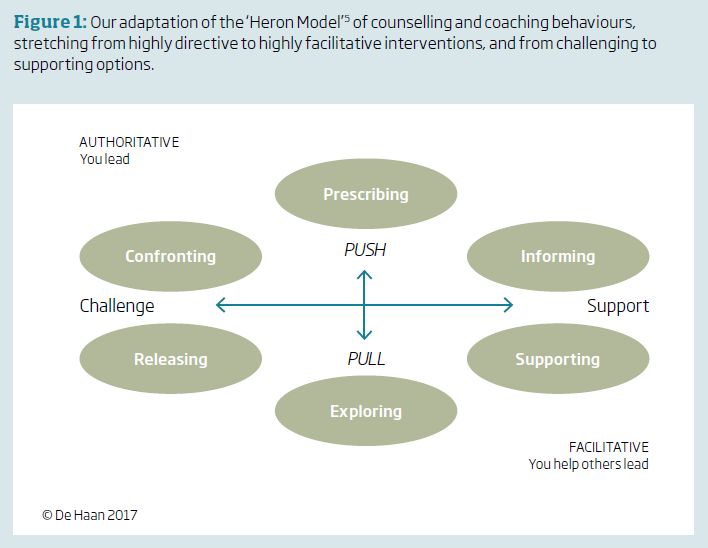We have recently studied coaching behaviours, both as reported by executive coaches, consultants and managers, and by these coaches’ clients.1 The latest version of our Coaching Behaviours Questionnaire (CBQ)2 was used in a large-scale study of coaching behaviours, among 537 coaches, 196 consultants and 559 manager-coaches from a total of 54 countries, and among 221 clients of coaching. The study demonstrated significant differences in perceived behaviour by subjects who differ in age, gender, and nationality. Significant differences were also found for those who identify themselves as ‘managers’ versus ‘consultants’ versus ‘coaches’, and for those looking at the behaviours from the other side of the relationship, the ‘clients’ of coaching. Some of the differences can be attributed to the fact that more experienced coaches will perceive themselves to develop different coaching behaviours.
As an executive coach, you have a wide array of behavioural responses at your disposal at any moment of executive coaching. The sheer number of possibilities can be dizzying and a real source of doubt and anxiety for coaches. As you mature and professionalise, you will continue to spend time reflecting on which of these ‘interventions’ to use and when.
Similarly, your coaching client wonders what to say, when to say it, and how to invite you as the coach in with your responses. At the same time, both you and your client are forming views of each other’s behaviours, and you are making inferences about what those behaviours tell you and how to respond.
In the coaching literature, there has been much discussion and a proliferation of models of what I would call ‘the coach’s best behaviours’, ie which interventions to use and when. Thus far, most of this debate has been without much evidential support, that is, without much knowledge of which behaviours coaches think they use and which behaviours clients think they receive (and vice versa). Measurements of coach behaviours or coaches’ and clients’ own views on coaching behaviours have been rare (for some exceptions, see Ianiro, Schermuly and Kauffeld3 and De Haan, Culpin and Curd4).
In order to start investigating coaching skills, we need a basic tool measuring the full range of interventions that is general and broad enough, not too detailed and complicated, and with a limited number of classes of interventions, so that reliable measurements can be made. The model should have high validity as well: both clients and coaches need to be able to recognise each of the classes of intervention from a short description, and their ratings should conform to their intuitive appreciation of the interventions. We have found such a model in the Coaching Behaviours Questionnaire2 (CBQ) with 72 items, which is an adaptation of the Heron (1975) model of counselling interventions.5 Summarising in brief, it has three ‘push’, coach-centred (directive) sets of behaviours—Prescribing, Informing, and Confronting—and three ‘pull’, client-centred (non-directive) sets of behaviours — Exploring, Supporting, and Releasing (see Figure 1).

The six classes of intervention illustrate that as a coach you have a broad range of interventions at your disposal. At any point in a coaching conversation, you will have the options of:
- not doing anything, devoting your energy to following the coachee and to listening
- offering direction, either by means of advice or suggestion (Prescribing) or by means of information that might help the coachee (Informing)
- offering a challenge to the coachee, consisting of a different way of looking at his or her issues (Confronting)
- offering facilitative interventions, by offering warmth and support (Supporting), an effort to summarise and inquire more deeply into the issues at stake (Exploring), or an invitation to open up emotional undercurrents to the issues and the conversation itself (Releasing).
With the CBQ, the coaching and consulting professions have a reliable and intuitive tool at their disposal to measure coaching behaviours through the eyes of coaches, consultants, manager-coaches, clients, and even observers. The statistical properties of this tool show that it can be used to make measurements that result in highly personal feedback to coaches, either given by themselves or by others. In the current version of the CBQ, this feedback is related to a large norm group of managers, consultants, and coaches, so participants are automatically compared with the norm group results of the group that they belong to. Moreover, all participants receive percentile scores that indicate what proportion of the norm group with their particular job description (manager, consultant, coach) score lower than they do on each of the six dimensions.
We were able to show that the CBQ is reliable and valid, and even that self-reported coach profiles change significantly with coach demographics such as age, gender, job description, and nationality. Finally, we found that client-reported behavioural profiles might be different from self-reported profiles of the same coach. Here are the systematic differences that we found in our sample between various groups of coaches and also between coaches and their clients:
First, women score themselves higher on the non-directive interventions and lower on the directive interventions than their male counterparts, while they do not differ significantly in the amount of ‘challenge’ and ‘support’ they think they give their coachees. Executive coaching has often been called a ‘female profession’ as it is geared towards receiving the client, nurturing the ideas and development of the client, and helping to look after the client’s agenda. These are perceived to be traditionally and biologically more female roles (see, for example, De Haan 20086). It is therefore interesting if these self-perceptions can also be picked up as different behaviour in practice. There is already some evidence that female coaches are slightly more effective in the eyes of clients than their male counterparts (see De Haan, Grant, Burger and Eriksson7).
Second, older coaches/consultants/ managers score significantly lower on directive interventions than their younger colleagues. They also reported giving less active support, while their emotionally Releasing interventions are more prevalent in their self-scores.
Third, job role also influences the scores on the questionnaire. Manager-coaches, consultant-coaches, and ‘professional’ coaches self-score progressively lower on directive and supportive interventions while they score themselves progressively higher on non-directive (Exploring and Releasing) interventions. In other words, participants who describe their job role as ‘coaches’ report a more ‘coaching’ (non-directive) profile in their scores. This may be the influence of progressive ‘acculturation’ in the consulting and coaching professions, where coaches learn to think about their interventions progressively in terms of more ‘typical’ coaching interventions, ie the ‘pull’ behaviours within Exploring and Releasing. In fact, we find that if client scores are compared with all three categories, the discrepancies are largest for professional coaches, which indicates that coaches may be changing their self perceptions more than their actual coaching behaviours.
Fourth, there are some significant differences in scores when measured against country of origin. We found substantial differences in terms of how many Confronting interventions have been reported: highest in The Netherlands, mid-level in Belgium, and lowest in the UK. There are significant differences in terms of how many Exploring interventions have been reported as well: highest in the UK, and lower in Belgium and The Netherlands. Similar contrasts of directness and ‘non-avoidance’ were reported by Van Meurs in her PhD thesis on negotiations between Dutch and UK managers.8 From personal experience and studying cultural assessments of national cultures (eg the dimension of internal versus external control in management consultant Trompenaars’ well-known seven-dimensional model9), we recognise the progressive increase in Confronting from the UK, to Belgium, and then to The Netherlands. Coach profiles from North America and the Middle East were also significantly different.
Fifth, clients of workplace coaches are scoring coaches significantly higher on directive interventions, while they score them significantly lower on some non-directive interventions. Three effects are significant, which show that clients see their coaches doing more Prescribing and Informing and less Releasing than coaches are scoring themselves. We believe this shows that coaches may be more central in their interventions than they themselves realise: they may be giving more advice (Prescribing) and information (Informing) than they think. Moreover, they do not go as deeply into the client’s inner world and emotions (Releasing) as they perceive themselves doing. We do not know if any of this ‘general feedback for coaches’ is related to skill; however, it is tempting to think that these coaches are sometimes so busy with their own ideas and suggestions that they attend less to their clients’ emotional process to be truly effective coaches. Certainly, their clients are saying to some significant extent that the coaches are doing this more than they themselves think. It would be worth testing if clients also wish their coaches to be less advisory, informing and more in tune with their own highly personal emotional experience. We know from other studies that clients may perceive the empathic behaviour of coaches differently from coaches themselves10 and that they perceive effectiveness of coaching quite differently from their coaches.7 Given that the client sample is still small and the effects are nonetheless large, we believe more research needs to be done and are looking forward to replicating this analysis with larger samples.
Sixth, we have found evidence that the differences in self-perceptions of coaches are not replicated by their clients, namely for the ‘gender’ and ‘job description’ dimensions where this could be tested. The sample is still relatively small so we need to be cautious in drawing conclusions; however, it seems that perhaps self-identification of female and professional coaches is more non-directive, while this does not show up as different behaviour towards the clients. It is always possible that such, perhaps more sophisticated, coaches change something about their behaviour that the client does not even notice while still being impacted; however as yet there is no evidence for a differential impact on clients.
This study shows that we can now reliably measure a wide range of coaching interventions and make powerful comparisons between samples of coaches and between the client and coach perspective on those same interventions. There seem to be systematic scoring patterns in terms of directive and non-directive coaching styles; and also in terms of the amount of support or challenge provided by the coach/consultant/manager. One might think of the patterns we found as indicative of development and adaptation, with older and professional coaches perceiving more ‘typical’ non-directive and client-centred coaching behaviours over time and as they specialise more as coaches. We have found some indications that these are mainly self-perceptions of the professional coaches, which are not shared by their clients. We found some confirmation that one can see coaching as more of a ‘female’ profession, with females perceiving more ‘typical’ coaching skills in their own work. Finally, we have found some evidence of coaches adapting to their national cultures and becoming more confrontational, direct or explorational in cultures where that is more the norm. However, the systematic patterns we have found still need to be linked back to measurable behaviours and skills – as this is not yet the case: we have only found evidence for patterns in the perceptions of coaching skills.
As a next step it would be interesting to bring in the observer’s perspective (both during live sessions and on the basis of recordings), and to compare scores directly on the same coaching relationship or session. The CBQ tool could be further modified to rate observed behaviour, both in terms of frequency of occurrence and impact/ effectiveness. When doing so, we believe this model should be extended with questions aimed at assessing the subtle overtones, nuances and ‘ulterior transactions’ contained within normal conversational behaviour. Ultimately, a tool like this can be used to assess the efficacy or skill of a coach to produce desired outcomes, namely when scores on this instrument are correlated with reliable outcome measures, eg in randomised controlled trials. Only at that time will we be able to establish whether the significant differences we have found between different coaching professionals are indicative of a different approach in their conversations and whether they correlate with differences in competence and, ultimately, in their effectiveness as coaches.
Dr Erik de Haan is Director of the Ashridge Centre for Coaching, and works extensively as an executive (team) coach, organisation development consultant and coaching supervisor. He has published 11 books and more than 150 scientific articles. Erik is also a psychodynamic psychotherapist and Professor of Organisation Development and Coaching at the VU University of Amsterdam.
More from Coaching Today

Coaching conversations: finding your niche
Open article: In a competitive workplace, it can make sense to identify a coaching niche. But are there also times when it pays to be a generalist? Sally Brown asks leading coaches for the lowdown on finding your USP and standing out from the crowd. Coaching Today, October 2017

Mapping the territory: navigating the journey into coaching
Open article: Maps can provide a useful framework in navigating the coaching process with our clients, but how do we ensure that we are not confusing the map with the territory? Carolyn Mumby explores. Coaching Today, July 2017

Navigating client diversity: why coaching needs formulation
Open article: How do we respond to the unique and idiosyncratic needs of our clients while also working within recognised frameworks? Sarah Corrie and Louise Kovacs present the case for applying formulation in a coaching context. Coaching Today, April 2017
References
1 For the full study, please consult De Haan E, Nilsson V. Evaluating coaching behavior in managers, consultants and coaches: a model, questionnaire, and initial findings. Consulting Psychology Journal 2017; 69(4): 315–333.
2 The first version of the questionnaire was created and used by Richard Phillips in 1994, and subsequent versions were developed with help from Alex Davda, Helen Lockett, Judy Curd and Viktor Nilsson at Ashridge. The CBQ questionnaire and client feedback version can be taken by writing to sarah.brooks@ashridge.org.uk.
3 Ianiro P M, Schermuly C C, Kauffeld S. Why interpersonal dominance and affiliation matter: an interaction analysis of the coach-client relationship. Coaching:An International Journal of Theory, Research and Practice 2013; 6(1): 25–46.
4 De Haan E, Culpin V, Curd J. Executive coaching in practice: what determines helpfulness for clients of coaching? Personnel Review 2011; 40(1): 24–44.
5 Heron J. Helping the client: a creative practical guide. London: Sage; 1975.
6 De Haan E. Relational coaching: journeys towards mastering one-to-one learning. Chichester: Wiley; 2008.
7 De Haan E, Grant A, Burger Y, Eriksson P-O. A large-scale study of executive coaching outcome: the relative contributions of working relationship, personality match, and self-efficacy. Consulting Psychology Journal: Practice and Research 2016; 68(3): 189–207.
8 Van Meurs N. Negotiations between British and Dutch managers: cultural values, approaches to conflict management, and perceived negotiation (PhD thesis). University of Sussex; 2003.
9 Trompenaars F, Hampden-Turner C. Riding the waves of culture: understanding diversity in global business. Oxford: McGraw-Hill; 1997.
10 Will T, Gessnitzer S, Kauffeld S. You think you are an empathic coach? Maybe you should think again. The difference between perceptions of empathy vs empathic behaviour after a person-centred coaching training. Coaching: An International Journal of Theory, Research and Practice 2016; 9(1): 53–68.
